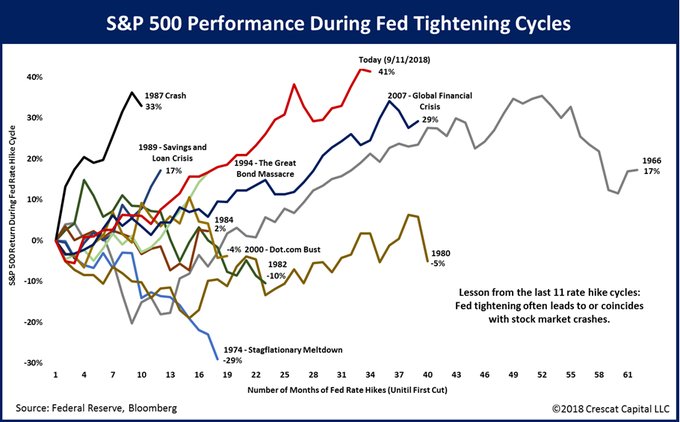The US stock market just keeps crushing historical records: longest bull market ever, S&P rising above 2,900, two trillion-dollar stocks, an unprecedented divergence between US stock and the rest of the world, and now - the strongest ever rally during a Fed tightening period.
According to an analysis by Crescat Capital's Tavi Costa, since the first rate hike by the Fed in December 2015, some 34 months ago, the S&P has risen by 41%: that puts this post-hike rally in the top spot of all previous market advances in a time when the Fed has been tightening financial conditions.
Of course, the reason for this relentless rally has been discussed extensively and has to do with fungible global liquidity, largely as a result of the ECB and BOJ still injecting liquidity, not to mention the SNB and various sovereign wealth funds recycling petrodollars and buying US stocks directly.
The question, however, as Costa puts it "How long until all hell breaks loose?"
This is a good question, because as Bloomberg writes, "the downfall that has often followed these rallies in the past" could - or rather should - be cause for concern. For example, the second-strongest rally before the current one, came just before the crash of 1987, with the S&P 500 rising 33% between the first interest rate increase and the first cut. Black Monday followed.
Since 2015, the Fed has raised seven times since 2015 and analysts predict it’s set to boost rates again when the central bank’s open market committee meets this month. However, one week ago Stifel's Barry Bannister calculated that the Fed will only be able to hike at most two more times before triggering a bear market, as the Fed Funds rate rises above the neutral rate of inflation in early 2019.
In a similar vein, earlier this year, Bank of America joined Deutsche Bank in warning that "every Fed tightening cycle has created a crisis."
More recently, on Tuesday SocGenchief economist Klaus Baader said that risks are growing as the global economic expansion ages, and noted factors such as trade tensions, emerging-market fragility, and monetary policy tightening.
“As the cycle matures, so exceptional monetary accommodation is being wound back, lessening the tailwinds for the U.S. economy,” he said.
Alternatively, some have suggested that a decade of persistently low interest rates and quantitative easing may make this time around different, although it is unclear if that means an even more violent crash when one finally does come.
Responding to the $64 trillion question, Natixis' chief economist, Joseph LaVorgna, said that how long this market can keep on running will depend on future central bank’s policies.
"What I tell people is, ‘The Fed no longer has your back,”’ LaVorgna said in an interview at Bloomberg’s New York headquarters. "We’re exiting a period of extraordinary monetary easing and going to a period where monetary policy is less accommodative."
This is shown in the chart below, a reminder that in the next few months the global liquidity injection will turn negative for the first time since the crisis.
Whether the algos will notice is a different question.
Fonte: qui




Nessun commento:
Posta un commento